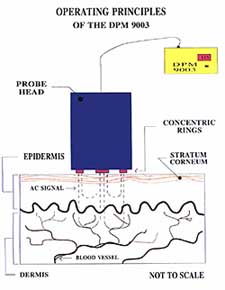
A Primer on DPM 9003 Impedance Measurements
Customers, researchers,
and prospective customers occasionally ask the question "Just what is
the DPM measuring?" Our reply is that the DPM 9003 is an "impedance"
measuring instrument. Impedance is the resistance to the flow of an
alternating current.
We asked one of our engineers to provide us with a short summary and
a primer that would help both NOVA™ customers and prospective customers
better understand how the NOVA™ DPM 9003 works, without making you
glassy-eyed by the physics and electrical engineering terminology. Herewith
are parts of his description that we feel will be very useful.
The electrical quantity "impedance" is the tendency of something to
resist the flow of an alternating current. "Conductance" is the inverse
of impedance, i.e., the tendency of something to pass electrical current.
Impedance and conductance are called "complex" quantities, because they
take two numbers to describe. There are two common ways of specifying
a complex quantity:
*Amplitude and phase
*Real part and imaginary part
These two ways of talking about a complex quantity are not independent.
One can be derived from the other. Sometimes it is more useful to talk
about "amplitude" and "phase", and at other times the "real" and "imaginary"
parts are more handy to the researcher. In skin, the amplitude (amount
of response) seems to go up with frequency, while the phase (amount
of lag) seems to generally go down. The opposite occurs with conductance.
Real and imaginary impedance are not different information, but just a
different way of showing a complex quantity. The "real" part is the
part that is synchronized with the stimulus, and the "imaginary" part
is the part that is out of synchronization. In the case of impedance,
the real part is called "resistance", and the imaginary part is called
"reactance". There are two kinds of reactance, depending on the algebraic
sign of the imaginary part. They are called "capacitance" and "inductance".
Skin seems to exhibit capacitive reactance for the most part.
When using the DPM 9003, the researcher will observe a readout on the
LCD when he or she places the sensor probe on the skin to take a reading.
The instrument will typically reflect a reading between 90-999 DPM units.
Mindful of the complex quantity of impedance as described above, we
chose to use the DPM unit which is a relative value or reading.
